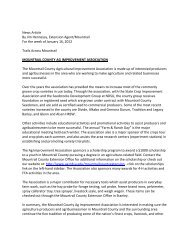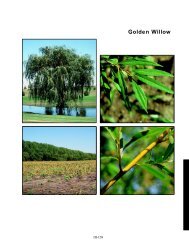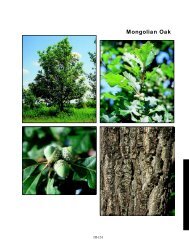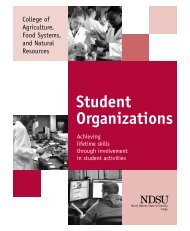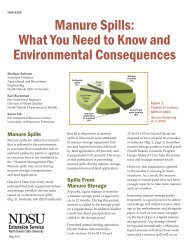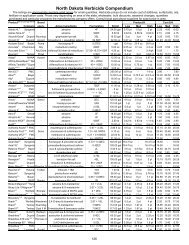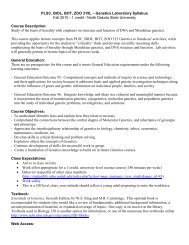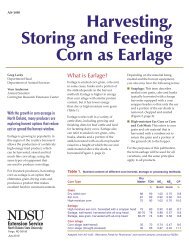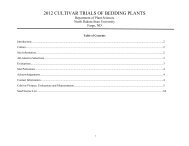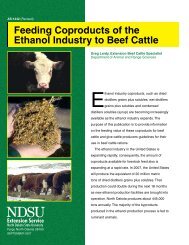NDSU Beef Feedlot - NDSU Agriculture - North Dakota State ...
NDSU Beef Feedlot - NDSU Agriculture - North Dakota State ...
NDSU Beef Feedlot - NDSU Agriculture - North Dakota State ...
You also want an ePaper? Increase the reach of your titles
YUMPU automatically turns print PDFs into web optimized ePapers that Google loves.
Weather<br />
The idea of ―winter‖ seems to be challenging and limits some from recognizing the opportunity for<br />
feeding cattle in <strong>North</strong> <strong>Dakota</strong>. Certainly, there are challenges to operating a feedyard in the cold,<br />
wind, and snow. Planning and preparation with appropriate facilities and equipment are important to<br />
managing winter weather. Shelterbelts for catching snow, feed storage and access, water fountains,<br />
and snow removal all affect winter operations. A detailed analysis would be useful to assess the effects<br />
of feeding animals in the cold vs. warmer but potentially wet and muddy conditions farther south.<br />
British-crossbred cattle adapt to cold to some degree even though cold temperatures increase<br />
maintenance energy requirements. Winter weather can be mitigated by providing wind protection and<br />
in some cases bedding animals. Dry, bedded pens have been proven to improve gains and efficiency<br />
with a net advantage to bedding reported as high as $80 per head from improved performance and<br />
increased carcass grade and value. Bedding animals also sequesters up to three times more nitrogen<br />
in the manure, increasing the fertilizer value by creating an optimum carbon-nitrogen ratio. The<br />
logistics of bedding can be challenging in large feedyards. Some yards box scrape pens on a regular<br />
basis to provide snow-free dirt pads for animals.<br />
Land<br />
Land costs in <strong>North</strong> <strong>Dakota</strong> are lower than virtually any state in the nation. Site selection for a livestock<br />
enterprise needs to consider water source and water table proximity, wind direction, proximity to towns<br />
or neighbors, durability of roads, rainfall, soil type, slope, feed sources, land to spread manure, and<br />
employee access. Information to assist in site selection is available from the <strong>North</strong> <strong>Dakota</strong> Stockmen’s<br />
Association environmental program director or from <strong>NDSU</strong> nutrient management specialists.<br />
Market Opportunities<br />
A number of auction markets operate throughout <strong>North</strong> <strong>Dakota</strong> where feeder cattle are offered for sale.<br />
The supply of feeder cattle is highly variable during the year based on marketing spring-born calves at<br />
weaning in the fall and into mid-winter. Spring and summer market volume is low.<br />
Terminal markets for fed cattle include large commercial packing houses (Tyson, Cargill, etc.), local<br />
butcher shops, and some auction markets. New terminal markets have been attempted in <strong>North</strong><br />
<strong>Dakota</strong> and some international business entities are working on plans for a new packing plant at this<br />
writing. The large commercial packing houses are located several hundred miles to the south, requiring<br />
significant expense to ship fat cattle to market.<br />
Labor<br />
People raised in <strong>North</strong> <strong>Dakota</strong> generally have a good work ethic. Some are gifted with husbandry skills<br />
and instinctively know how to ―read‖ cattle and provide appropriate feed, management, and care for<br />
optimum performance. Labor for feedlot operations, including pen riders, truck drivers, maintenance<br />
people, and cattle processing crews can sometimes be challenging.<br />
Challenges<br />
In some areas, crop producers do not have appropriate appreciation for the value of manure as a<br />
fertilizer. It is important to capture income from every aspect of livestock production that has real value.<br />
This point is evidence that <strong>North</strong> <strong>Dakota</strong> has lost some of its livestock ―culture‖ or appreciation for the<br />
intergration of crops and livestock production. Although many young people have expressed interest in<br />
developing livestock enterprises, besides simply being interested in livestock production, the<br />
acceptance of risk and the annual cycle of the farm business must be accepted and managed.<br />
Knowing how to manage commodity price risk through market positions, futures, options and other<br />
instruments can increase the odds of approved credit lines from lenders, although some lending<br />
agencies are not livestock savvy or have had less than positive experiences with some livestock<br />
enterprises. New or expanding livestock producers need a good business plan that identifies all the<br />
Page 53 2009 <strong>NDSU</strong> <strong>Beef</strong> <strong>Feedlot</strong> Research Report




